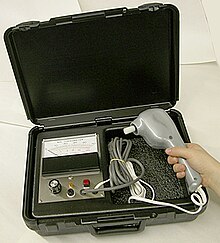

Biothesiometry is a noninvasive medical test used to quantify the perception of vibration by measuring its threshold. It is used in neurology and electrophysiology to diagnose a number of conditions, like diabetic neuropathy and erectile dysfunction, where the vibration perception threshold (VPT) would be higher than average. The numerical nature of the test can help stage the progression of disease or complications.
The test is done through a biothesiometer, which is composed of a handheld probe wired to a display unit. Both digital and analog types are commercially available, giving the reading on either a dial or a screen.
In a systematic review of screening methods for pediatric diabetic peripheral neuropathies, biothesiometry and fine microfilaments were shown to be the only diagnostic methods with high sensitivity and specificity.
A systematic review showed that there is a strong co-relation between HbA1c values and Vibration Perception Test and could be a predictor for complications in the foot following Diabetic Peripheral Neuropathy.
In a systemic review of modern devices available for the assessment and screening of peripheral neuropathy, digital devices were evaluated to measure tactile sensation, vibration perception, thermal perception and foot skin temperature.
References
- ^ Mulhall, John P.; Jenkins, Lawrence C. (2017), Mulhall, John P.; Jenkins, Lawrence C. (eds.), "Biothesiometry", Atlas of Office Based Andrology Procedures, Cham: Springer International Publishing, pp. 9–14, doi:10.1007/978-3-319-42178-0_2, ISBN 978-3-319-42176-6, retrieved 2022-02-27
- Davis, E. A.; Jones, T. W.; Walsh, P.; Byrne, G. C. (Sep 1997). "The use of biothesiometry to detect neuropathy in children and adolescents with IDDM". Diabetes Care. 20 (9): 1448–1453. doi:10.2337/diacare.20.9.1448. ISSN 0149-5992. PMID 9283795. S2CID 12199660.
- Hirschfeld, Gerrit; von Glischinski, Michael; Blankenburg, Markus; Zernikow, Boris (2014-05-01). "Screening for Peripheral Neuropathies in Children With Diabetes: A Systematic Review". Pediatrics. 133 (5): e1324 – e1330. doi:10.1542/peds.2013-3645. ISSN 0031-4005. PMID 24709928. S2CID 1973886.
- Maiya, Arun G.; Parameshwar, Anche; Hande, Manjunath (2020). "Relationship Between Glycated Hemoglobin and Vibration Perception Threshold in Diabetic Peripheral Neuropathy". The International Journal of Lower Extremity Wounds. 19 (2): 120–124. doi:10.1177/1534734619882173. ISSN 1552-6941. PMID 31838926. S2CID 209384436.
- Riddhi, Dasgupta; Jebasingh, Felix; Thomas, Nihal; Kn, Maruthy; Sharma, Sanjay; Saravanan, Bharathi (2022). "NEURO TOUCH: A novel digital device for assessment and screening of peripheral neuropathy". The Foot. 51: 101888. doi:10.1016/j.foot.2021.101888. ISSN 0958-2592. PMID 35255407. S2CID 244933416.
This article related to medical equipment is a stub. You can help Misplaced Pages by expanding it. |